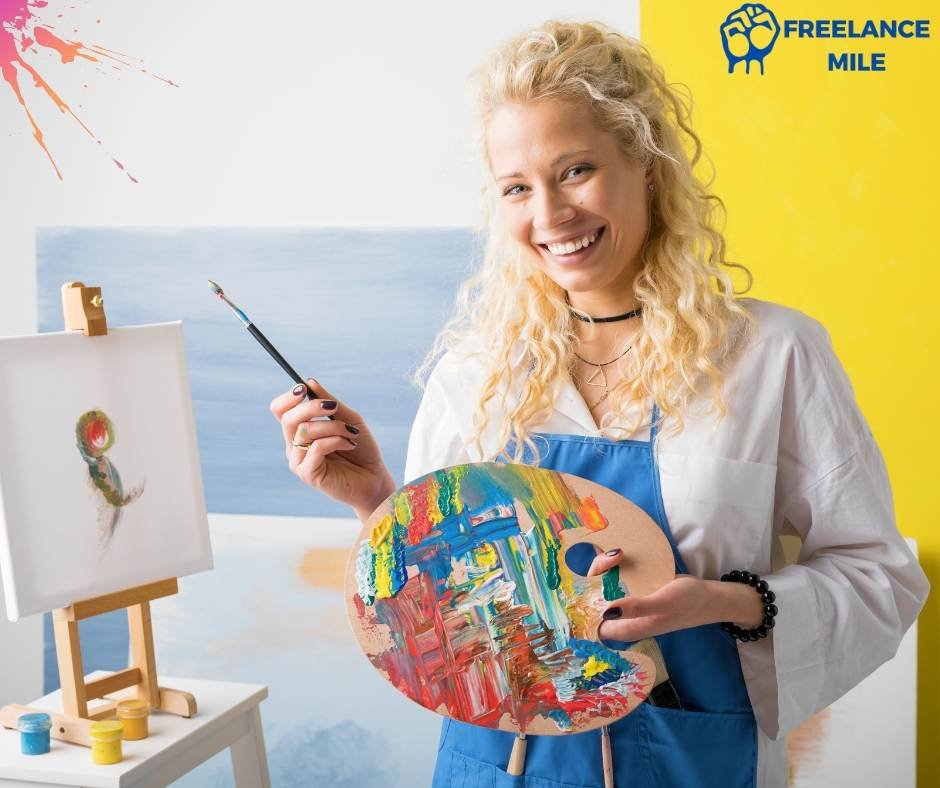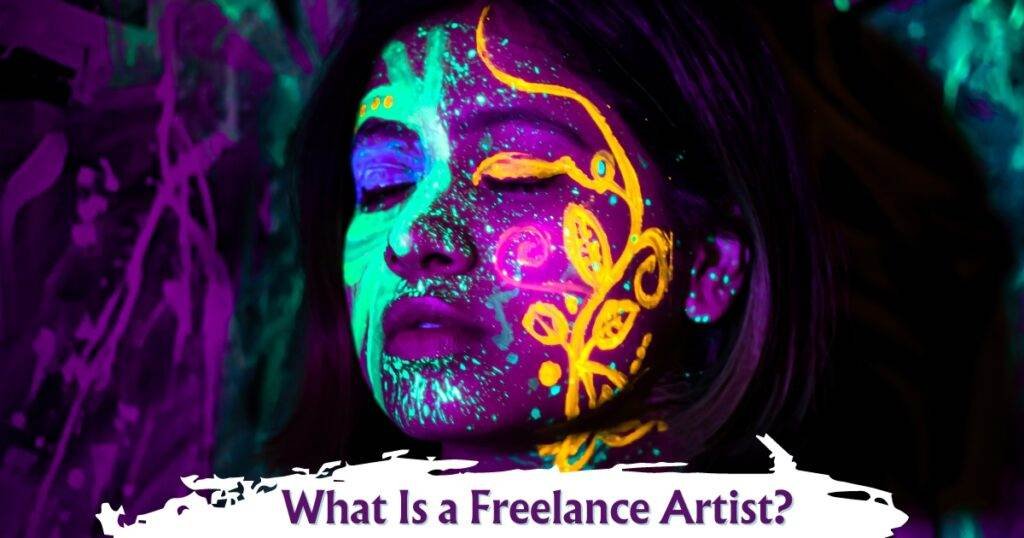A freelance artist is a independent contractor who is self-employed and offers their creative services on a project-by-project basis, rather than being employed by a single company. They may work on a variety of projects, such as designing logos, creating murals, illustrating books, or producing digital art for video games.
To learn more about each aspect of being a freelance artist, continue reading the article below.
What Is a Freelance Artist? Understanding the Concept
So you’ve heard the term “freelance artist” floating around and you’re wondering, what on earth does that mean? Is it some sort of secret society where artists roam free, unbound by the constraints of a 9-to-5 job? Well, not exactly, but it’s close.
A freelance artist is essentially an independent contractor within the world of art. This means they’re self-employed, and not tied down to a specific company or employer. Instead, they work on a project-by-project basis, providing their artistic services to various clients.
They could be doing anything from designing logos, creating murals, illustrating books, to even crafting digital art for video games. The sky’s the limit, really!
Life as a Freelance Artist: More than Just Art Creation

Now, when you picture a freelance artist, you might imagine someone peacefully at work, their canvas filled with vibrant colors as they lose themselves in their craft. While this is a part of the reality, there’s much more to it. Understanding what is a freelance artist involves recognizing that they do more than just create art; they also manage their own business operations.
As a freelance artist, you’re not just an artist; you’re also a business owner. This means you’re responsible for:
- Marketing your services: This could involve creating a portfolio, running a website, and networking. You can’t just create art and expect clients to come running. You’ve got to get yourself out there!
- Communicating with clients: This includes everything from discussing project specifics, negotiating fees, to providing updates on your progress. Good communication skills are a must in the freelance world.
- Managing your business: This involves setting your rates, invoicing clients, tracking your expenses, and even filing your taxes. It’s not all fun and games, but it’s part and parcel of the freelance life.
The Evolution of Freelancing in the Arts
The term ‘freelance’ itself has an interesting history. It was first coined in Sir Walter Scott’s novel, Ivanhoe, referring to free-lance knights who were not bound to any lord. They were, in essence, ‘free’ to provide their services to the highest bidder.
Today, the world of freelancing has evolved into a global marketplace, where artists can connect with clients from all over the world. The evolution of freelancing in the arts brings us back to the fundamental question: what is a freelance artist in today’s world?
Being a freelance artist comes with its own set of challenges, but it also offers an unparalleled level of freedom and flexibility. It allows you to pursue your passion, on your own terms. You can choose the projects you want to work on, set your own rates, and even work from anywhere in the world. Now, isn’t that something worth striving for?
So, are you ready to take the leap into the world of freelancing? Remember, every great journey begins with a single step. And as always, freelancemile.com is here to guide you every step of the way. After all, the freelance mile is always easier when you’re not walking it alone.
Stepping into the Freelance Art World

Embarking on a freelance art career can feel like stepping into a vast, unknown wilderness. It’s thrilling, but can also be intimidating. But worry not, my fellow adventurers! With the right preparation, mindset, and a bit of humor, you too can navigate this terrain and make it your own.
Planning Your Journey: Launching Your Freelance Art Career
Becoming a freelance artist isn’t an overnight endeavor. Like prepping for a long hike, there are essential steps to take before you set off on your journey. Start with industry research. Get to know the lay of the land, the market’s needs, and where your skills fit in. Next, build your skillset.
Learn, practice, refine. Remember, it takes time to build Rome, and the same goes for creating masterpieces or establishing a successful freelance career.
Claiming Your Digital Space: Website and Online Portfolio
Your digital portfolio serves as your online business card. It showcases your work and helps prospective clients determine if they want to hire you. So, make it count! Use high-quality images and give each piece a context—tell the stories behind them.
Not tech-savvy? No problem! Platforms like Wix and Squarespace are user-friendly and perfect for showcasing your talent.
Additionally, for artists looking to enhance their digital portfolio, Adobe Creative Cloud offers a range of tools and step-by-step tutorials that can help in creating professional and visually appealing artwork. You can explore these resources here
Setting Up Your Creative Sanctuary: Your Workspace
A dedicated and organised workspace is essential for productivity and mental clarity, whether it’s a small corner or a separate studio.
Crossing The Legal Bridge: Business Registration and Taxes
Not the most exciting part of being a freelance artist, but definitely one of the most critical. Register your business, understand your tax obligations, and don’t hesitate to get professional advice if needed. Remember, it’s better to be safe than sorry when dealing with Uncle Sam!
Hunting For Opportunities: Finding Your First Clients
Landing your first clients can be exhilarating. Use your network, pitch to potential clients, or consider platforms like Upwork or Freelancer. Remember, the first few may be the toughest to get, but they’re also the most rewarding!
Showcasing Your Journey: Building Your Portfolio
As you continue to create, your portfolio should grow and evolve with you. It should showcase your range of skills, your versatility, and your unique style. Remember, it’s your story, so make sure it reflects who you are as an artist.
Spreading the Word: Advertising and Social Media
With the power of social media, marketing your freelance art services has never been easier. Use Instagram, Pinterest, or even TikTok to reach potential clients and fellow artists. Just remember, it’s not just about posting – it’s about engaging!
Becoming a Community Player: Building Goodwill
Engaging with your local and online communities is a potent tool. Offer art classes, collaborate with other artists, or donate your work for a good cause. Remember, good vibes attract good opportunities!
Keeping the Momentum: Produce Art Regularly
One of the key secrets to a successful freelance art career is consistency. Keep creating, keep experimenting, and keep pushing your boundaries. Remember, you’re not just an artist; you’re a creative entrepreneur!
Expanding Your Horizons: Freelance Workspaces & Opportunities
Freelance artists are not confined to a single workspace or platform. Job sites like Behance, ArtStation, and even LinkedIn can be treasure troves of opportunities. And let’s not forget the perks of working from home – pajamas as work attire, anyone?
There you have it, folks. The path to becoming a successful freelance artist might be winding and a bit rocky, but with these steps, you’re well on your way. Remember, every journey starts with a single step – or in this case, a single brushstroke!
Developing Your Artistic Brand: Identifying Your Unique Value Proposition

What makes you – yes, you – stand out in the sea of artists out there? It’s your unique value proposition (UVP). As the name suggests, your UVP is what you bring to the table that’s distinct and valuable. Part of developing your artistic brand as a freelance artist is understanding and articulating what is a freelance artist’s unique value proposition.
Maybe you’re a watercolor whiz who specializes in pet portraits, or perhaps you’re a digital artist with a knack for creating otherworldly landscapes. Whatever your niche, it’s crucial to pinpoint it and market it effectively.
Remember, you’re not just an artist; you’re a brand. And like any brand, you need to differentiate yourself from the competition. But how do you identify your UVP? Start by asking yourself these questions:
- What do I excel at?
- What do I enjoy doing most?
- What makes my art different?
- What do my clients value about my work?
Once you’ve identified your UVP, it’s time to broadcast it to the world – or at least, to potential clients.
Using SEO to Enhance Visibility
You’ve got your UVP nailed down. Now, it’s time to make sure people can find you online. Enter SEO – Search Engine Optimization. It’s not as scary as it sounds, I promise.
SEO is all about making your online presence more visible to search engines like Google. The better your SEO, the higher your website will rank in search results, increasing your potential to attract new clients.
A great place to start is by optimizing your portfolio website with relevant keywords. For example, if you’re a logo designer, make sure to include words and phrases like “freelance logo designer,” “custom logos,” and “logo design services” throughout your site.
It’s also helpful to use SEO tools like Google’s Keyword Planner to find popular keywords related to your work. SEO is a marathon, not a sprint. It requires time and consistency, but the payoff is worth the effort.
Managing Your Freelance Art Business: Setting Rates and Negotiating Contracts
Now, let’s talk money. Setting rates and negotiating contracts can be daunting, especially when you’re just starting. But don’t sweat it – you’ve got this.
When setting your rates, consider factors like the complexity of the project, the time it will take, and your level of expertise. Research what other artists in your niche are charging, but remember – you’re not them. Your rates should reflect your worth.
As for contracts, they’re non-negotiable. A well-drafted contract protects both you and your client, outlining project scope, timelines, payment terms, and more. If you’re unsure where to start, there are plenty of freelancing platforms and resources that offer contract templates.
Handling Finances and Taxes
As a freelancer, you’re not just an artist; you’re also a business owner, which means handling finances and taxes. It might not be the most glamorous part of freelancing, but trust me – it’s essential.
It is important to open a separate business bank account for better tracking of income and expenses. Also, consider using an accounting software to keep your finances organized.
As a freelancer, it’s important to remember that you’re responsible for paying your own taxes. This means you need to set aside a portion of your income specifically for taxes. It’s also a good idea to hire a tax professional who is familiar with freelance taxes to help you navigate the process.
Time Management and Productivity
Effective time management is crucial for freelancer success. Start by prioritizing your tasks according to their urgency and importance, and use tools like Google Calendar or Trello to track deadlines and manage your workflow.
Remember to take breaks regularly. Studies show that taking breaks can actually increase productivity, so don’t hesitate to take a walk or grab a cup of coffee when you need to recharge.
Navigating Challenges and the Market: COVID-19’s Impact on Freelance Artists and the Gig Economy
Now, let’s address the elephant in the room – COVID-19. The pandemic has undoubtedly shaken up the freelancing world, but it’s not all doom and gloom.
While some industries have taken a hit, others have seen a surge in demand. For example, with more businesses going digital, there’s been a rise in demand for digital art and graphic design.
The key is to adapt and diversify. Now might be the time to explore new mediums or offer new services. Remember, challenges often bring opportunities – it’s all about perspective.
Tips for Achieving Success as a Freelance Artist
Finally, some parting wisdom. Success as a freelance artist doesn’t happen overnight – it takes time, patience, and a whole lot of hustle. But with a clear brand, effective marketing, sound business practices, and a dash of resilience, you can build a freelance art career that’s not only sustainable but also rewarding.
So, what are you waiting for? It’s time to start your freelancing journey. Remember, the road may be winding, but at the end of it, lies the freedom and fulfillment of being your boss.
And there you have it – your ultimate guide to freelancing as an artist. Now, go forth and create!
The Future of Freelance Artistry: A Canvas of Opportunities
“Starving artist” no more! Welcome to the future of freelance artistry, where dreams become reality and creativity fetches a pretty penny. With the digital revolution, the art industry has seen a significant shift.
More and more artists are ditching the traditional 9-5 grind and embracing the dynamic world of online freelancing. But what does the future hold for freelance artists? Let’s delve deeper.
Unleashing Your Creativity into a Digital World
The rise of the digital world has created many opportunities for artists to showcase their talents and earn a substantial income. Here’s a sneak peek into the future trends of freelance artistry:
- Digital Art: With the advent of digital tools and platforms, art has expanded beyond the canvas. Virtual reality art, digital painting, and 3D modeling are some fields gaining momentum.
- Niche Specialization: As the competition grows, specializing in a niche such as animation, game design, or infographic design can set you apart.
- Artistic Entrepreneurship: As a freelance artist, you’re not just an artist but also an entrepreneur. Understanding marketing, networking, and business strategy will be crucial in the future.
As a freelance artist, it is crucial to continuously improve your skills and keep up with industry trends in order to maintain your competitive edge.
Overcoming Challenges in Freelance Artistry: Navigating Bumpy Roads

Every rose has its thorns, and freelancing is no exception. Here are some common pitfalls and how to avoid them:
- Inconsistent Work: Yes, freelancing can be a roller coaster ride. One way to smooth out the ride is by diversifying your client base and marketing your services through different platforms.
- Client Disputes: The key to avoiding disputes is clear communication. Make sure to have a detailed contract outlining the scope of work, deadline, revisions, and payment terms.
- Isolation: Freelancing can sometimes feel lonely. Networking with other freelancers or joining art communities can help you stay connected and inspired.
Staying Inspired and Avoiding Burnout: Keep the Fire Burning
Maintaining creativity can be challenging, especially when you’re juggling multiple projects. Here are some strategies to keep the creative juices flowing:
- Take Regular Breaks: Remember, you’re a human, not a machine. It’s important to take regular breaks as it can improve your productivity and creativity.
- Keep Learning: Exploring new art techniques or tools can reignite your passion and inspire new ideas.
- Mindfulness Practices: Incorporating mindfulness practices like meditation or yoga can help manage stress and keep burnout at bay.
Recap of Key Takeaways: Your Freelancing Guide
As we wrap up our journey into the future of freelance artistry, here are the key takeaways:
- Embrace digital trends and niche specialization.
- Overcome challenges by diversifying your client base, emphasizing clear communication, and networking.
- Stay inspired and avoid burnout by taking regular breaks, continuing to learn, and practicing mindfulness.
Final Thoughts from an Industry Expert: Your Art, Your Rules
As the founder of freelancemile.com, and a seasoned freelancer, I, Rohan Garg, want to leave you with these parting words. Your art is unique, and so is your journey. Give yourself the permission to make mistakes, learn, and grow. Remember, freelancing isn’t just a career; it’s a lifestyle. So, are you ready to paint the future with your creativity?
FAQ
How Much Do Freelance Artists Make?
Earnings for freelance artists can vary widely depending on their experience, location, and the demand for their services in the market.While some artists may earn a modest income, others may achieve significant earnings. Various key factors contribute to this, including:
– Experience and Specialization: Artists with unique skills and experience often earn more.
– Location: Artists based in urban areas or regions with a strong art presence may have higher income opportunities.
– Market Demand: Income can fluctuate depending on trends and art styles that are currently popular.
– Project-Based Work: Earnings can vary from month to month depending on the number and size of projects.
– Diverse Income Sources: Many artists supplement their income through teaching, selling artwork, or creating online content.
Overall, a freelance artist’s income is impacted by a combination of their skills, adaptability, and market conditions.
What qualifies as a freelance artist?
So, you’ve heard the term “freelance artist” and you’re wondering, “What in the Picasso is that?” Well, let me paint you a picture (yes, pun intended). Essentially, when we ask ‘what is a freelance artist?’, we’re inquiring about the qualifications and characteristics that define this independent artistic role.
A freelance artist is essentially a self-employed artist. Unlike traditional artists who might work for a company or studio, freelance artists work for themselves. They’re their own bosses (cue boss music), picking and choosing projects they want to work on, setting their own rates, and working from the comfort of their own studio (or, more realistically, their living room).
What is the difference between an artist and a freelance artist?
Both create art, both can have their work displayed in galleries, and both probably drink an unholy amount of coffee. But the key difference lies in the employment status.
Many businesses and creative teams hire artists who specialize in traditional art techniques. These artists are often offered additional benefits such as health insurance and retirement plans. Freelance artists, on the other hand, work independently, hustling for each project they undertake. They enjoy more freedom in choosing their projects but also bear the responsibility of running their own business.
Is it hard to be a freelance artist?
Well, let’s put it this way: it’s not exactly a walk in an art park. But then again, neither is any freelancing gig, right? The truth is, it can be challenging. You’re your own boss, remember? You’ll have to manage your own workload, find your own clients, and handle your own taxes (yikes!).
However, it’s not all gloom and doom.
As a freelance artist, you get to choose the projects you’re passionate about, set your own rates, work from anywhere, and wear whatever you want (yes, even that old, paint-splattered T-shirt you love).
What skills do you need to be a freelance artist?
Aside from the ability to create art (duh), being a successful freelance artist requires a mix of artistic and business skills. Here’s a quick rundown:
– Artistic Skills: You’ll need a strong portfolio showcasing your work and versatility. You should also have a good understanding of art techniques, materials, and software relevant to your field.
– Business Skills: As you’ll be running your own business, you’ll need skills in areas like marketing, negotiation, and financial management. You’ll also need to be a self-starter, able to motivate yourself and manage your time effectively.
– Communication Skills: You’ll be liaising with clients, so good communication is key. This includes everything from negotiating fees to understanding and delivering on the client’s vision.
Remember, just like any masterpiece, building a career as a freelance artist isn’t created overnight. It takes time, patience, and a whole lot of practice.
But with the right skills, persistence, and a dash of creativity, you can turn that blank canvas into a thriving online freelancing journey.




